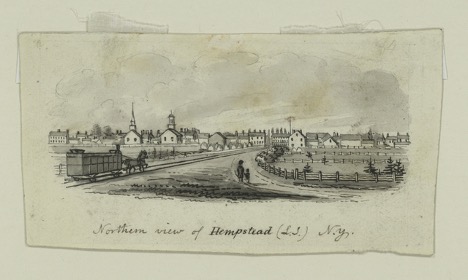By Charlotte Crozier
In early September 1722, Dick (last name once known) fled from Ezekiel Balding of Hempstead, Long Island, New York, seeking reprieve from the conditions that his enslavement had forced him to endure. Though Dick’s exact ambitions after self-emancipation are unrecorded, unidentified sources in his runaway advertisement suggested that he sought a possible return to the Native community. Some speculated that perhaps he had traveled “towards New-London [CT] and Rhode-Island”—whether to rejoin his family, to disappear among the forests of New England, or attempt to board maritime vessels destined for new lands remains unknown. What is known is that Balding published an advertisement in the American Weekly Mercury, a Philadelphia newspaper, on November 23, 1722, seeking the forcible return of Dick. Considering that the ad was published over two months after Dick’s courageous act of self-emancipation and the search extended to Philadelphia, Balding made significant efforts to find and re-enslave Dick.1

Like many other “runaway” ads, Balding’s notice describes Dick in ways that would help lead to his capture. These noted features are likely not at all how Dick would have described himself. Balding described Dick’s “Middle Stature and … smiling Countenance,” possibly in recognition of his good-natured and affable demeanor. Baldwin claimed that Dick spoke English and no other language, which is a gesture toward the fact that many enslaved people, and even enslaved Indigenous people, were still actively being captured and trafficked from places where English was not their first language. Notably, the ad states that Dick could read, which he likely leveraged to strengthen his claims to freedom.
Descriptions of clothing were also important aids in helping white colonists track down self-emancipated individuals. Baldwin notes that Dick was wearing a “home-spun Shirt and a dark-coloured Drugget Coat,” and the assumption was that he would still have had on those same clothes even months later. The coat especially would have been useful for Dick as he would have had to contend with the falling temperatures and cold nights following the autumn equinox.
It is unclear in what capacity Dick worked for Balding, although the “white scratches on his Arm” suggest that his labor may have been physical. The newspaper also notes that he had a “blue spot on the Inside of one of his Wrists.” This ambiguous spot may well have been a tattoo and thus, a signifier of Dick’s original tribal community.2 Indeed, Sassidillah, another enslaved Native American man recorded within the Stolen Relations database, has a similar blue marking “across the Temples on the right Side of his Face.”3 It is equally possible that Dick’s marking was a birthmark, perhaps a “Mongolian blue spot,” a form of “dermal melanocytosis,” which leaves blue-hued, circular markings on the skin and is particularly common among Indigenous people.4
Though Ezekiel Balding reappears in colonial documentation, purchasing another individual by the name of “Daniel Whitehead” in 1738, Dick seems to not be included in all other official records.5 One can hope that his self-emancipation was successful, offering him the opportunity to reunite with his Indigenous community or to live as a free man, unburdened and unrestricted by enslavement.
For further reading
Morgan, Philip D. “Origins of American Slavery,” Magazine of History 19, no. 4 (July 2005): 2, https://www.proquest.com/docview/213743530?fromopenview=true&pq-origsite=gscholar&sourcetype=Scholarly%20Journals.
Keefer, Katrina H.B. “Marked by fire: brands, slavery, and identity,” A Journal of Slave and Post-Slave Studies 40, no. 4 (May 7, 2019) https://doi.org/10.1080/0144039X.2019.1606521.
Footnotes
- Information contained in this story that is not otherwise footnoted comes from advertisement in the American Weekly Mercury.[↩]
- Sinclair, A. T., “Tattooing of the North American Indians,” American Anthropologist 11, no. 3 (1909): 391, http://www.jstor.org/stable/659626.[↩]
- “Sassidillah,” Stolen Relations Database[↩]
- Gupta, Divya and Thappa, Devinder Mohan, “Mongolian spots: How important are they?” World J Clin Cases 1, no.8 (November 16, 2013), https://www.ncbi.nlm.nih.gov/pmc/articles/PMC3856299/.[↩]
- “Notes for Daniel Whitehead and Elinor Willett,” University of Michigan, https://websites.umich.edu/~bobwolfe/gen/mn/m22147x20896.htm.[↩]